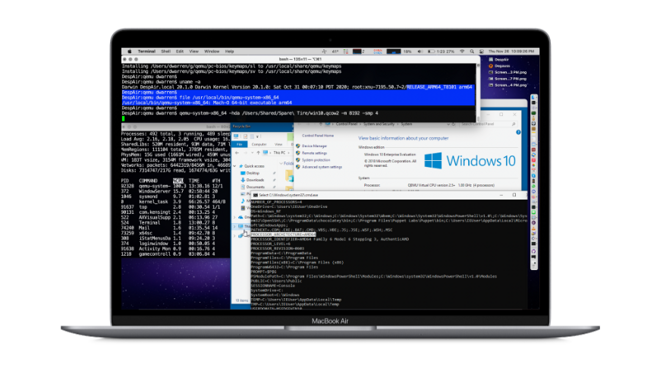Developer devises workaround to run ARM Windows on M1 Mac
Using some custom patches to popular virtualization tool QEMU, a developer has managed to launch Windows for ARM processors on a M1 Mac with decent results.

Run ARM based Windows with QEMU
The ability to run Windows for ARM processors has been in question since Apple revealed its Macs running custom Apple Silicon. The closest to a confirmation so far had been Craig Federighi stating that is "a decision Microsoft has to make."
Users have been tinkering with custom software and emulation tools to try and get Windows to work, and one developer finally succeeded. The developer in question used QEMU and custom patches to get the OS running and claims it runs smoothly enough, and can even run some x86 apps.
Graf claims to have achieved "near-native" performance though it is still early days. Other users trying to perform the same operation report slow startup times and lagging apps when operating normally. When QEMU is running ARM Windows, battery life is effectively cut in half.
Microsoft may release an official version of ARM Windows for consumers to purchase and run on M1 based Macs, but the timeline is unclear. Microsoft has not given any official statement regarding even working on such compatibility.

Run ARM based Windows with QEMU
The ability to run Windows for ARM processors has been in question since Apple revealed its Macs running custom Apple Silicon. The closest to a confirmation so far had been Craig Federighi stating that is "a decision Microsoft has to make."
Users have been tinkering with custom software and emulation tools to try and get Windows to work, and one developer finally succeeded. The developer in question used QEMU and custom patches to get the OS running and claims it runs smoothly enough, and can even run some x86 apps.
The details of this workaround were covered by The 8-Bit, with the report stating the developer was able to run the preview version of ARM Windows by using the Hypervisor.framework. This framework lets users virtualize software without dealing with kernel extensions.Who said Windows wouldn't run well on #AppleSilicon? It's pretty snappy here . #QEMU patches for reference: https://t.co/qLQpZgBIqI pic.twitter.com/G1Usx4TcvL
-- Alexander Graf (@_AlexGraf)
Graf claims to have achieved "near-native" performance though it is still early days. Other users trying to perform the same operation report slow startup times and lagging apps when operating normally. When QEMU is running ARM Windows, battery life is effectively cut in half.
Microsoft may release an official version of ARM Windows for consumers to purchase and run on M1 based Macs, but the timeline is unclear. Microsoft has not given any official statement regarding even working on such compatibility.


Comments
-M
The ship times are crazy. Mine is like a month. These new models are selling like hotcakes.
I’m hopeful. I have to use Windows, and Apple always made the best Windows machines imho.
Like running Linux, FreeBSD, bare metal virtualization software allowing near-instant switching between macOS and other operating systems, etc. etc.
Someone should have asked Craig Federighi THAT question...
I don’t agree with those who say this would be batting against their OEMs. I’ve read a couple of articles that said that, and they’re wrong...completely. Microsoft mostly sells software and services. Nobody commented negatively about Microsoft on Macs. I believe that even their OEMs know that licensing software to anyone that fits the description is what Microsoft does. Therefor, Apple would just be another pc maker. After all, writing Windows for ARM itself is a departure from tradition. And it’s possible that Microsoft might not have to do too much. Besides, don’t forget that for these OEMs, Microsoft has already undermined them directly by making their own hardware lines. If that wasn’t a problem, then this certainly won’t be.
What bugs me is that it’s sitting in “preparing order” for over a week now, even though the first day, it said that everything needed for my order was there. Supposedly the 3rd to the 10th. Well, it won’t be the third. I hope it will get here before the tenth.
There’s only one chip it runs on. A slightly modified chip from Qualcomm. Much slower than the M1, much slower than the A14, or the A13.